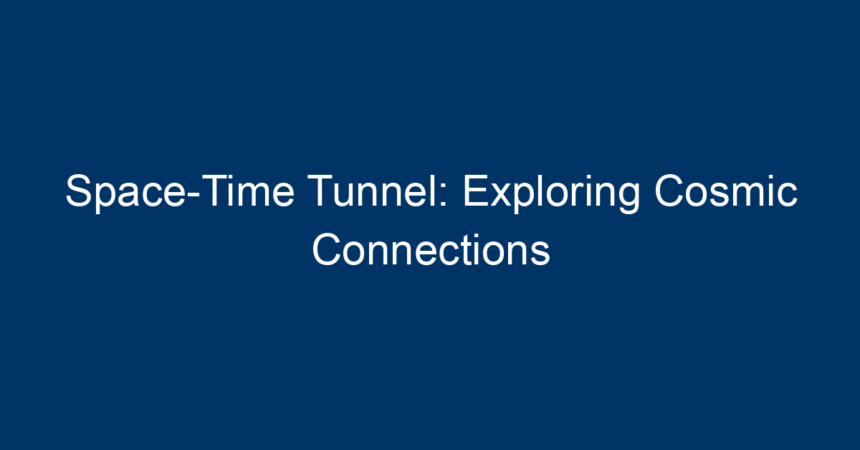The universe is a vast and enigmatic place, full of mysteries waiting to be unraveled. Among the most fascinating concepts in modern physics is the notion of the space-time tunnel. This idea doesn’t merely belong to the realm of science fiction; it offers a potential bridge between our understanding of the cosmos and the fabric of reality itself. In this article, we will explore the concept of space-time tunnels, their implications for time travel, and the intersection between physics and philosophy.
What is a Space-Time Tunnel?
At its core, a space-time tunnel is a theoretical passage through the fabric of space-time, often referred to as a wormhole. Imagine a shortcut that could connect two distant points in the universe, potentially allowing for instant travel across vast distances. This concept suggests that space and time are not merely linear constructs but can bend or fold on themselves under certain conditions.
The Foundations of Space-Time
Understanding space-time requires delving into the fundamentals of physics. Albert Einstein’s theory of relativity revolutionized how we perceive time and space. According to this theory, space and time are intertwined into a single continuum. Massive objects like stars and planets warp this space-time fabric, resulting in gravitational forces. A space-time tunnel is a hypothetical manifestation of this fabric being manipulated to create shortcuts through space.
The Mechanics of Wormholes
The term "wormhole" is a common synonym for space-time tunnels, and it’s defined mathematically by solutions to the Einstein field equations. Let’s explore the two main types of wormholes:
1. Traversable Wormholes
These are hypothetical structures that could connect two different points in space-time, theoretically permitting travel from one end to the other. To be traversable, a wormhole would need to be stable and large enough to allow matter to pass through without collapsing. The concept of exotic matter, which has negative energy density, is often invoked to keep the tunnel open.
2. Schwarzschild Wormholes
These are more often known as black holes. While they don’t fit the classic definition of a space-time tunnel, black holes can lead to potential tunnels that connect different parts of the universe. However, they present unique challenges, including extreme gravitational forces.
Time Travel: The Ultimate Application of Space-Time Tunnels
One of the most enticing implications of space-time tunnels is their potential use for time travel. Could humanity one day traverse the fabric of time itself? Let’s examine some key theories:
The Grandfather Paradox
The prospect of time travel introduces complex scenarios like the infamous grandfather paradox, where a traveler could potentially prevent their own existence by affecting past events. This paradox raises philosophical questions about causality and linear time, making the use of space-time tunnels for time travel an area ripe for exploration.
Closed Time-like Curves
Another fascinating concept related to space-time tunnels is closed time-like curves (CTCs). These theoretical paths allow an object to return to its own past, suggesting that time may not be as linear as we perceive. Researchers are exploring how CTCs could be linked to wormholes, which could revolutionize our understanding of time.
The Philosophical Implications of Space-Time Tunnels
The concept of a space-time tunnel isn’t merely a scientific curiosity—it probes the philosophical dimensions of existence itself. Here are some of the discussions surrounding its implications:
Determinism vs. Free Will
If space-time tunnels allow for time travel, what does that mean for the future? Are events predetermined, or do we have the ability to change them? This question dives deep into the discussion of determinism and free will, challenging our understanding of choice and consequence.
The Nature of Reality
If space-time tunnels exist and can be traversed, they raise questions about the nature of reality. Are multiple realities possible? How does perception change if one can experience different times and places? This ties into the multiverse theory, which posits that infinite parallel universes exist.
Scientific Research and Theories about Space-Time Tunnels
While space-time tunnels remain largely theoretical, ongoing research continues to explore their feasibility. Here are some significant developments:
Quantum Physics and Wormholes
The field of quantum physics offers tantalizing insights into the quantum realm that may allow for the existence of wormholes. Theoretical physicists are exploring concepts like quantum entanglement and the role it may play in creating stable wormholes.
Hawking Radiation and Black Holes
Stephen Hawking’s theories on black holes, particularly his concept of Hawking radiation, have implications for the understanding of space-time tunnels. If black holes can emit radiation and eventually evaporate, could they be gateways rather than endpoints?
Practical Considerations and Limitations
As enthralling as the idea of space-time tunnels may be, we must acknowledge the limitations and challenges involved:
Energy Requirements
Creating a stable space-time tunnel would likely require colossal amounts of energy, far beyond our current capabilities. Theoretical models suggest amounts comparable to the mass-energy of entire stars might be necessary.
Stability and Safety
Even if we could create a wormhole, ensuring it remains stable presents another layer of complexity. The extreme gravitational forces involved could pose unforeseen dangers to any travelers.
The Future of Space-Time Exploration
As technology advances, the exploration of space-time tunnels could transition from theoretical to practical. Here are some actionable insights for enthusiasts:
Educate Yourself
Stay updated with the latest research in physics, especially in areas related to relativity and quantum mechanics. Books, podcasts, and documentaries can be excellent resources.
Engage in Discussions
Join forums and communities that focus on theoretical physics. Engaging with like-minded individuals can help broaden your understanding of complex topics like space-time tunnels.
Support Scientific Research
Consider supporting scientific organizations and initiatives that focus on research in theoretical physics. Every contribution can help fuel groundbreaking discoveries.
Conclusion
The concept of the space-time tunnel offers an intriguing glimpse into the future of physics and our understanding of the universe. While there are significant challenges and limitations, the exploration of these ideas can inspire new generations of scientists and thinkers. Ultimately, the journey to uncover the secrets of the cosmos is just beginning, and we stand on the cusp of potentially understanding our reality in ways we could only dream of.
So, grab your telescopes and keep your minds open as we explore the exciting possibilities offered by space-time tunnels! The universe has much more to teach us, and it may just be a tunnel away.




